Economics and International Trade: Australian Mining Industry Report
VerifiedAdded on 2021/06/17
|9
|2936
|25
Report
AI Summary
This report provides a comprehensive economic analysis of the Australian mining industry, with a specific focus on iron ore. It begins with an introduction highlighting the industry's significance to the Australian economy, including its contribution to GDP and exports. The report then delves into the market structure, characterizing the iron ore market as oligopolistic, dominated by a few major players like BHP and Rio Tinto, and examines the cost curves and barriers to entry. The report identifies the determinants of iron ore demand, such as steel production and economic growth in emerging markets like China, and the determinants of supply, including global demand and the number of producers. It also discusses the inelastic demand for iron ore. Finally, the report analyzes a recent event, the Brazil dam disaster, and its potential impact on Australian iron ore prices and global supply chains, concluding with a discussion on the industry's current state and future outlook.
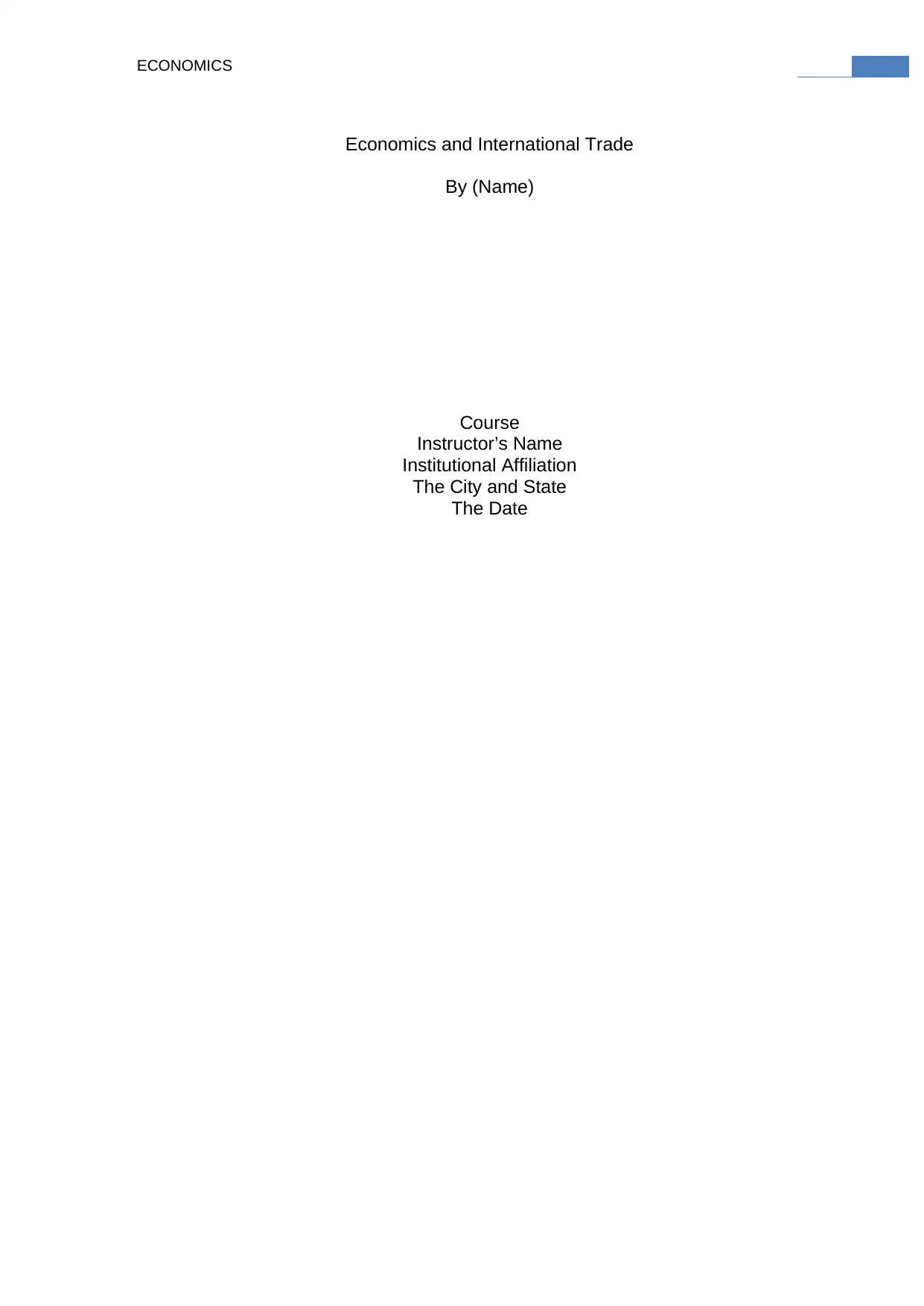
0ECONOMICS
Economics and International Trade
By (Name)
Course
Instructor’s Name
Institutional Affiliation
The City and State
The Date
Economics and International Trade
By (Name)
Course
Instructor’s Name
Institutional Affiliation
The City and State
The Date
Paraphrase This Document
Need a fresh take? Get an instant paraphrase of this document with our AI Paraphraser
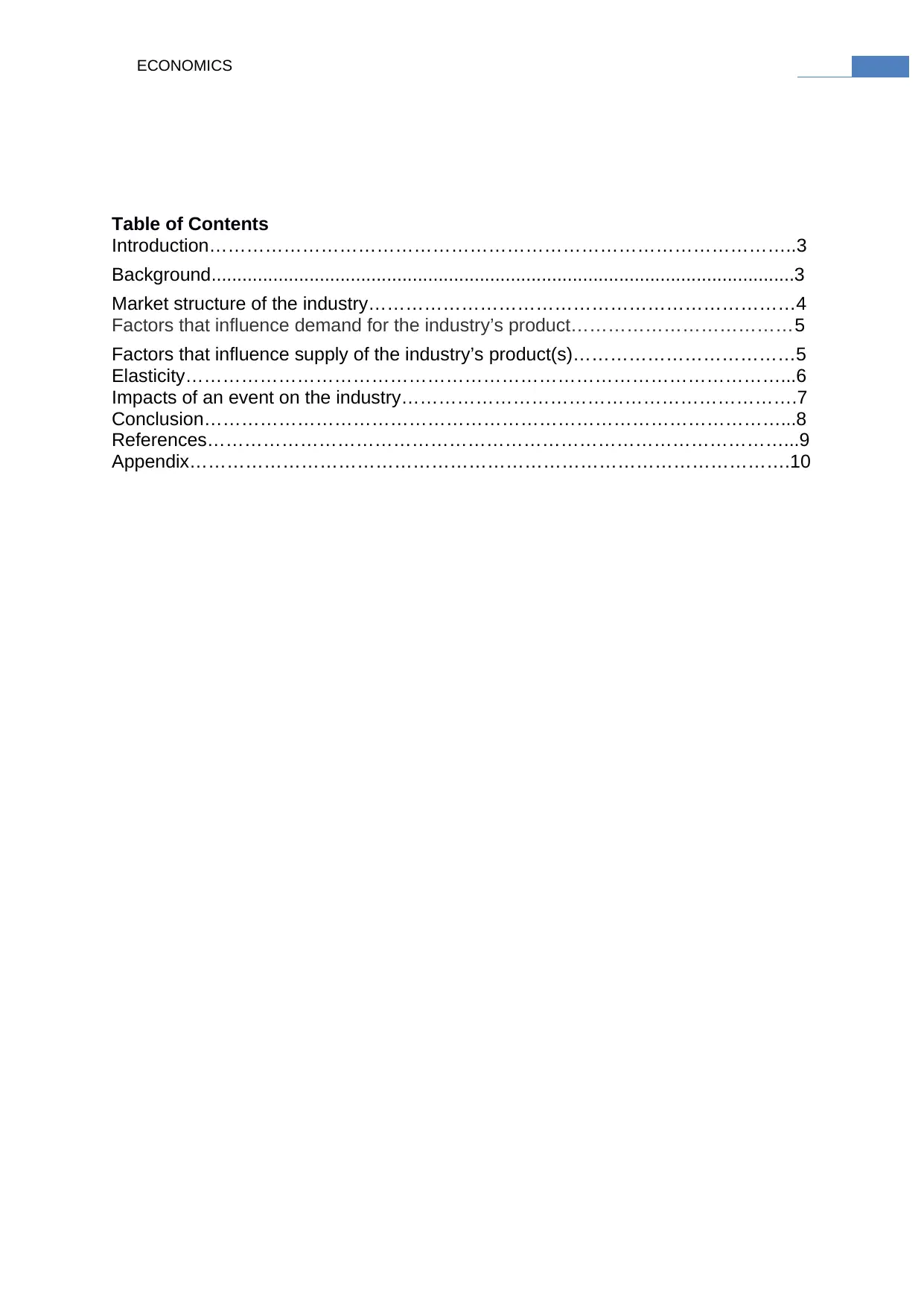
1ECONOMICS
Table of Contents
Introduction…………………………………………………………………………………..3
Background.................................................................................................................3
Market structure of the industry……………………………………………………………4
Factors that influence demand for the industry’s product………………………………5
Factors that influence supply of the industry’s product(s)………………………………5
Elasticity……………………………………………………………………………………...6
Impacts of an event on the industry……………………………………………………….7
Conclusion…………………………………………………………………………………...8
References…………………………………………………………………………………...9
Appendix…………………………………………………………………………………….10
Table of Contents
Introduction…………………………………………………………………………………..3
Background.................................................................................................................3
Market structure of the industry……………………………………………………………4
Factors that influence demand for the industry’s product………………………………5
Factors that influence supply of the industry’s product(s)………………………………5
Elasticity……………………………………………………………………………………...6
Impacts of an event on the industry……………………………………………………….7
Conclusion…………………………………………………………………………………...8
References…………………………………………………………………………………...9
Appendix…………………………………………………………………………………….10
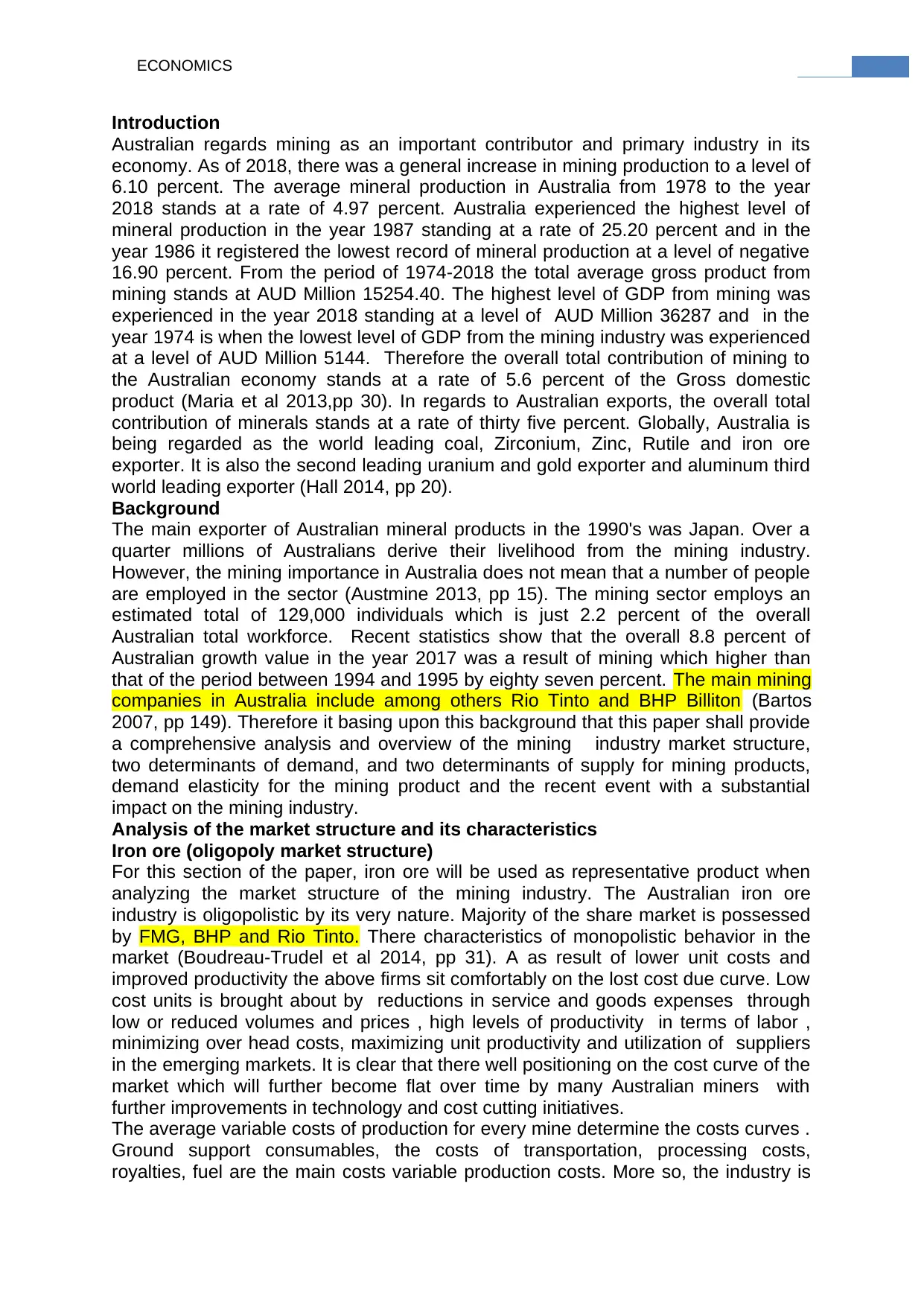
2ECONOMICS
Introduction
Australian regards mining as an important contributor and primary industry in its
economy. As of 2018, there was a general increase in mining production to a level of
6.10 percent. The average mineral production in Australia from 1978 to the year
2018 stands at a rate of 4.97 percent. Australia experienced the highest level of
mineral production in the year 1987 standing at a rate of 25.20 percent and in the
year 1986 it registered the lowest record of mineral production at a level of negative
16.90 percent. From the period of 1974-2018 the total average gross product from
mining stands at AUD Million 15254.40. The highest level of GDP from mining was
experienced in the year 2018 standing at a level of AUD Million 36287 and in the
year 1974 is when the lowest level of GDP from the mining industry was experienced
at a level of AUD Million 5144. Therefore the overall total contribution of mining to
the Australian economy stands at a rate of 5.6 percent of the Gross domestic
product (Maria et al 2013,pp 30). In regards to Australian exports, the overall total
contribution of minerals stands at a rate of thirty five percent. Globally, Australia is
being regarded as the world leading coal, Zirconium, Zinc, Rutile and iron ore
exporter. It is also the second leading uranium and gold exporter and aluminum third
world leading exporter (Hall 2014, pp 20).
Background
The main exporter of Australian mineral products in the 1990's was Japan. Over a
quarter millions of Australians derive their livelihood from the mining industry.
However, the mining importance in Australia does not mean that a number of people
are employed in the sector (Austmine 2013, pp 15). The mining sector employs an
estimated total of 129,000 individuals which is just 2.2 percent of the overall
Australian total workforce. Recent statistics show that the overall 8.8 percent of
Australian growth value in the year 2017 was a result of mining which higher than
that of the period between 1994 and 1995 by eighty seven percent. The main mining
companies in Australia include among others Rio Tinto and BHP Billiton (Bartos
2007, pp 149). Therefore it basing upon this background that this paper shall provide
a comprehensive analysis and overview of the mining industry market structure,
two determinants of demand, and two determinants of supply for mining products,
demand elasticity for the mining product and the recent event with a substantial
impact on the mining industry.
Analysis of the market structure and its characteristics
Iron ore (oligopoly market structure)
For this section of the paper, iron ore will be used as representative product when
analyzing the market structure of the mining industry. The Australian iron ore
industry is oligopolistic by its very nature. Majority of the share market is possessed
by FMG, BHP and Rio Tinto. There characteristics of monopolistic behavior in the
market (Boudreau-Trudel et al 2014, pp 31). A as result of lower unit costs and
improved productivity the above firms sit comfortably on the lost cost due curve. Low
cost units is brought about by reductions in service and goods expenses through
low or reduced volumes and prices , high levels of productivity in terms of labor ,
minimizing over head costs, maximizing unit productivity and utilization of suppliers
in the emerging markets. It is clear that there well positioning on the cost curve of the
market which will further become flat over time by many Australian miners with
further improvements in technology and cost cutting initiatives.
The average variable costs of production for every mine determine the costs curves .
Ground support consumables, the costs of transportation, processing costs,
royalties, fuel are the main costs variable production costs. More so, the industry is
Introduction
Australian regards mining as an important contributor and primary industry in its
economy. As of 2018, there was a general increase in mining production to a level of
6.10 percent. The average mineral production in Australia from 1978 to the year
2018 stands at a rate of 4.97 percent. Australia experienced the highest level of
mineral production in the year 1987 standing at a rate of 25.20 percent and in the
year 1986 it registered the lowest record of mineral production at a level of negative
16.90 percent. From the period of 1974-2018 the total average gross product from
mining stands at AUD Million 15254.40. The highest level of GDP from mining was
experienced in the year 2018 standing at a level of AUD Million 36287 and in the
year 1974 is when the lowest level of GDP from the mining industry was experienced
at a level of AUD Million 5144. Therefore the overall total contribution of mining to
the Australian economy stands at a rate of 5.6 percent of the Gross domestic
product (Maria et al 2013,pp 30). In regards to Australian exports, the overall total
contribution of minerals stands at a rate of thirty five percent. Globally, Australia is
being regarded as the world leading coal, Zirconium, Zinc, Rutile and iron ore
exporter. It is also the second leading uranium and gold exporter and aluminum third
world leading exporter (Hall 2014, pp 20).
Background
The main exporter of Australian mineral products in the 1990's was Japan. Over a
quarter millions of Australians derive their livelihood from the mining industry.
However, the mining importance in Australia does not mean that a number of people
are employed in the sector (Austmine 2013, pp 15). The mining sector employs an
estimated total of 129,000 individuals which is just 2.2 percent of the overall
Australian total workforce. Recent statistics show that the overall 8.8 percent of
Australian growth value in the year 2017 was a result of mining which higher than
that of the period between 1994 and 1995 by eighty seven percent. The main mining
companies in Australia include among others Rio Tinto and BHP Billiton (Bartos
2007, pp 149). Therefore it basing upon this background that this paper shall provide
a comprehensive analysis and overview of the mining industry market structure,
two determinants of demand, and two determinants of supply for mining products,
demand elasticity for the mining product and the recent event with a substantial
impact on the mining industry.
Analysis of the market structure and its characteristics
Iron ore (oligopoly market structure)
For this section of the paper, iron ore will be used as representative product when
analyzing the market structure of the mining industry. The Australian iron ore
industry is oligopolistic by its very nature. Majority of the share market is possessed
by FMG, BHP and Rio Tinto. There characteristics of monopolistic behavior in the
market (Boudreau-Trudel et al 2014, pp 31). A as result of lower unit costs and
improved productivity the above firms sit comfortably on the lost cost due curve. Low
cost units is brought about by reductions in service and goods expenses through
low or reduced volumes and prices , high levels of productivity in terms of labor ,
minimizing over head costs, maximizing unit productivity and utilization of suppliers
in the emerging markets. It is clear that there well positioning on the cost curve of the
market which will further become flat over time by many Australian miners with
further improvements in technology and cost cutting initiatives.
The average variable costs of production for every mine determine the costs curves .
Ground support consumables, the costs of transportation, processing costs,
royalties, fuel are the main costs variable production costs. More so, the industry is
⊘ This is a preview!⊘
Do you want full access?
Subscribe today to unlock all pages.

Trusted by 1+ million students worldwide
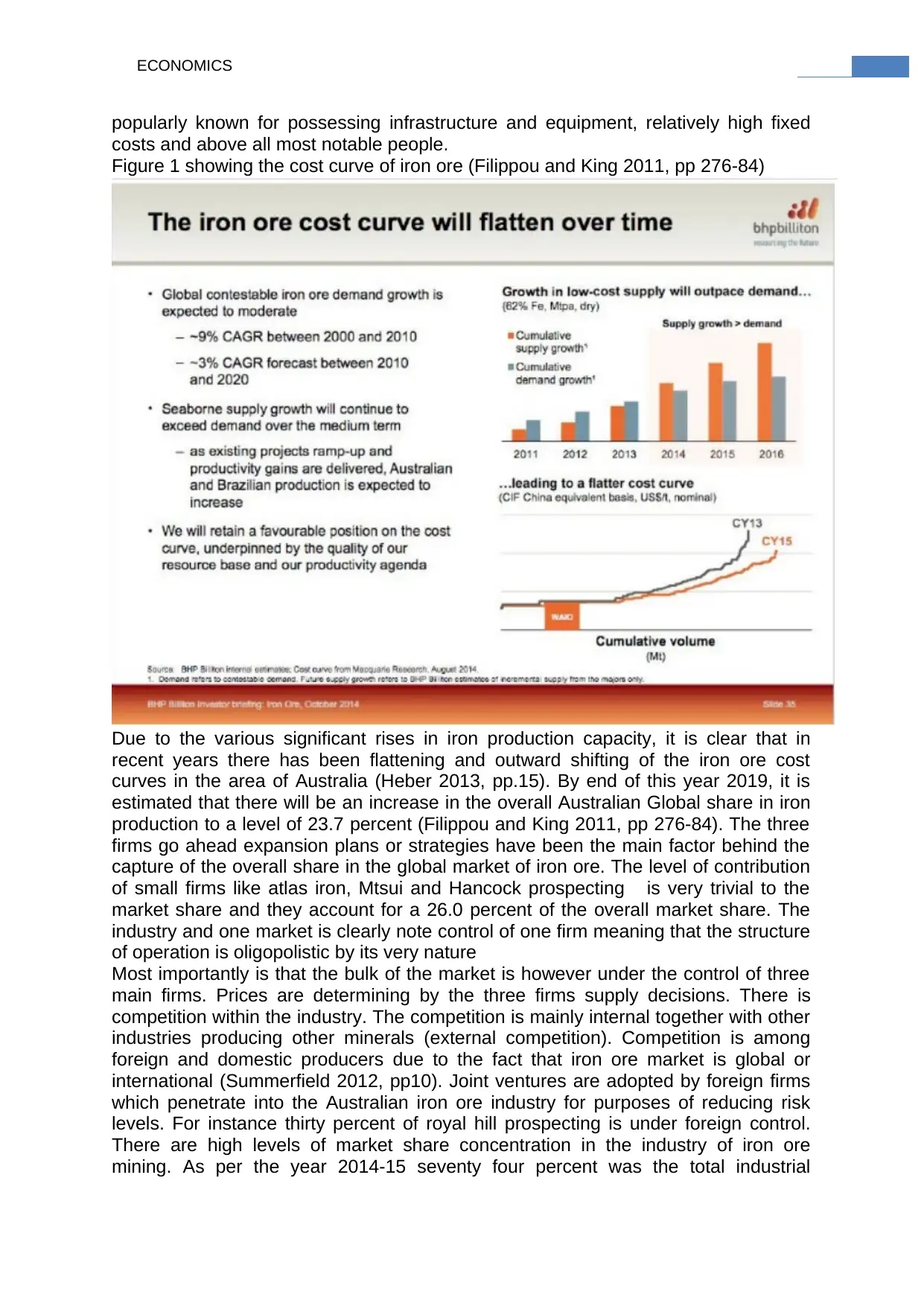
3ECONOMICS
popularly known for possessing infrastructure and equipment, relatively high fixed
costs and above all most notable people.
Figure 1 showing the cost curve of iron ore (Filippou and King 2011, pp 276-84)
Due to the various significant rises in iron production capacity, it is clear that in
recent years there has been flattening and outward shifting of the iron ore cost
curves in the area of Australia (Heber 2013, pp.15). By end of this year 2019, it is
estimated that there will be an increase in the overall Australian Global share in iron
production to a level of 23.7 percent (Filippou and King 2011, pp 276-84). The three
firms go ahead expansion plans or strategies have been the main factor behind the
capture of the overall share in the global market of iron ore. The level of contribution
of small firms like atlas iron, Mtsui and Hancock prospecting is very trivial to the
market share and they account for a 26.0 percent of the overall market share. The
industry and one market is clearly note control of one firm meaning that the structure
of operation is oligopolistic by its very nature
Most importantly is that the bulk of the market is however under the control of three
main firms. Prices are determining by the three firms supply decisions. There is
competition within the industry. The competition is mainly internal together with other
industries producing other minerals (external competition). Competition is among
foreign and domestic producers due to the fact that iron ore market is global or
international (Summerfield 2012, pp10). Joint ventures are adopted by foreign firms
which penetrate into the Australian iron ore industry for purposes of reducing risk
levels. For instance thirty percent of royal hill prospecting is under foreign control.
There are high levels of market share concentration in the industry of iron ore
mining. As per the year 2014-15 seventy four percent was the total industrial
popularly known for possessing infrastructure and equipment, relatively high fixed
costs and above all most notable people.
Figure 1 showing the cost curve of iron ore (Filippou and King 2011, pp 276-84)
Due to the various significant rises in iron production capacity, it is clear that in
recent years there has been flattening and outward shifting of the iron ore cost
curves in the area of Australia (Heber 2013, pp.15). By end of this year 2019, it is
estimated that there will be an increase in the overall Australian Global share in iron
production to a level of 23.7 percent (Filippou and King 2011, pp 276-84). The three
firms go ahead expansion plans or strategies have been the main factor behind the
capture of the overall share in the global market of iron ore. The level of contribution
of small firms like atlas iron, Mtsui and Hancock prospecting is very trivial to the
market share and they account for a 26.0 percent of the overall market share. The
industry and one market is clearly note control of one firm meaning that the structure
of operation is oligopolistic by its very nature
Most importantly is that the bulk of the market is however under the control of three
main firms. Prices are determining by the three firms supply decisions. There is
competition within the industry. The competition is mainly internal together with other
industries producing other minerals (external competition). Competition is among
foreign and domestic producers due to the fact that iron ore market is global or
international (Summerfield 2012, pp10). Joint ventures are adopted by foreign firms
which penetrate into the Australian iron ore industry for purposes of reducing risk
levels. For instance thirty percent of royal hill prospecting is under foreign control.
There are high levels of market share concentration in the industry of iron ore
mining. As per the year 2014-15 seventy four percent was the total industrial
Paraphrase This Document
Need a fresh take? Get an instant paraphrase of this document with our AI Paraphraser
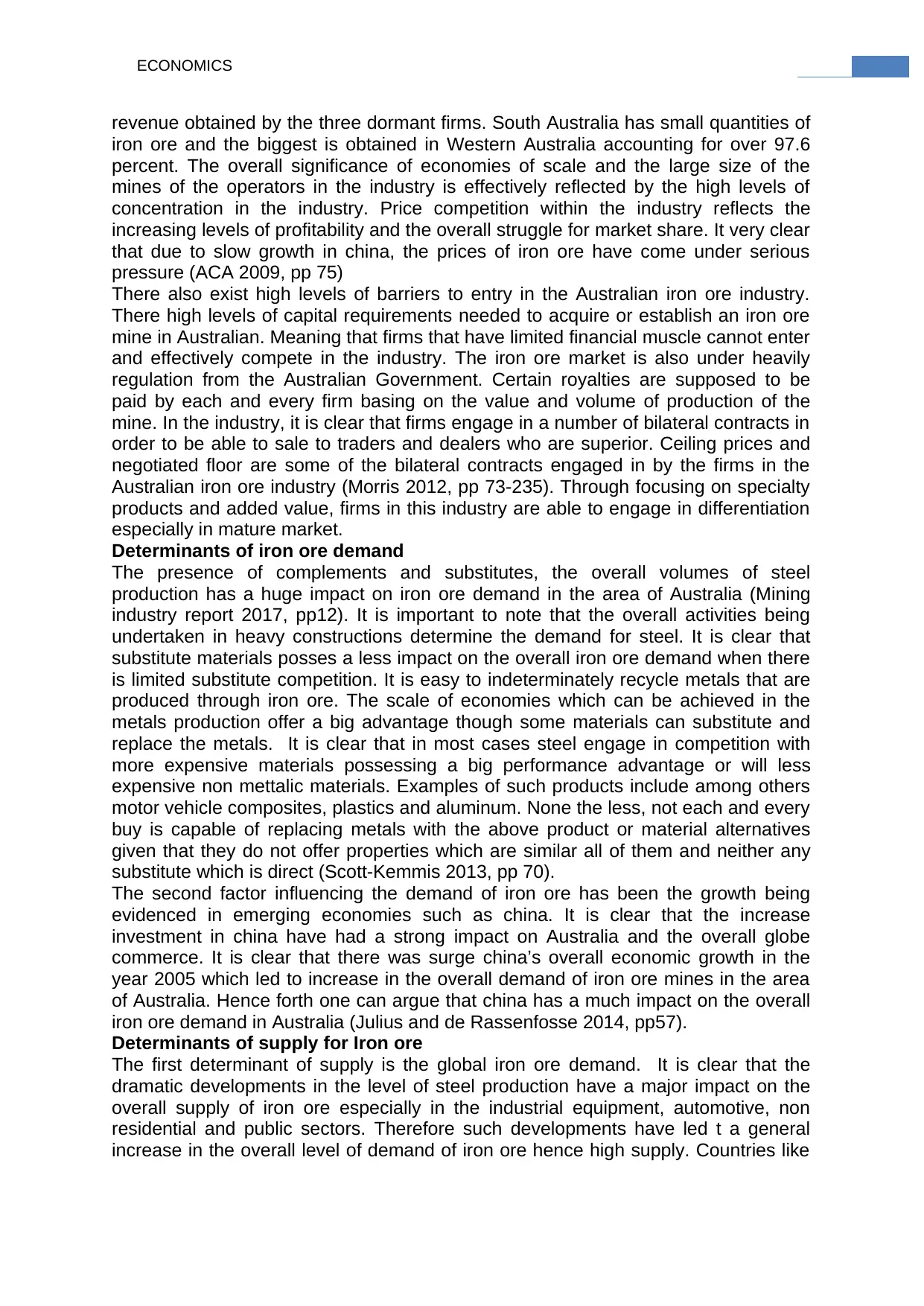
4ECONOMICS
revenue obtained by the three dormant firms. South Australia has small quantities of
iron ore and the biggest is obtained in Western Australia accounting for over 97.6
percent. The overall significance of economies of scale and the large size of the
mines of the operators in the industry is effectively reflected by the high levels of
concentration in the industry. Price competition within the industry reflects the
increasing levels of profitability and the overall struggle for market share. It very clear
that due to slow growth in china, the prices of iron ore have come under serious
pressure (ACA 2009, pp 75)
There also exist high levels of barriers to entry in the Australian iron ore industry.
There high levels of capital requirements needed to acquire or establish an iron ore
mine in Australian. Meaning that firms that have limited financial muscle cannot enter
and effectively compete in the industry. The iron ore market is also under heavily
regulation from the Australian Government. Certain royalties are supposed to be
paid by each and every firm basing on the value and volume of production of the
mine. In the industry, it is clear that firms engage in a number of bilateral contracts in
order to be able to sale to traders and dealers who are superior. Ceiling prices and
negotiated floor are some of the bilateral contracts engaged in by the firms in the
Australian iron ore industry (Morris 2012, pp 73-235). Through focusing on specialty
products and added value, firms in this industry are able to engage in differentiation
especially in mature market.
Determinants of iron ore demand
The presence of complements and substitutes, the overall volumes of steel
production has a huge impact on iron ore demand in the area of Australia (Mining
industry report 2017, pp12). It is important to note that the overall activities being
undertaken in heavy constructions determine the demand for steel. It is clear that
substitute materials posses a less impact on the overall iron ore demand when there
is limited substitute competition. It is easy to indeterminately recycle metals that are
produced through iron ore. The scale of economies which can be achieved in the
metals production offer a big advantage though some materials can substitute and
replace the metals. It is clear that in most cases steel engage in competition with
more expensive materials possessing a big performance advantage or will less
expensive non mettalic materials. Examples of such products include among others
motor vehicle composites, plastics and aluminum. None the less, not each and every
buy is capable of replacing metals with the above product or material alternatives
given that they do not offer properties which are similar all of them and neither any
substitute which is direct (Scott-Kemmis 2013, pp 70).
The second factor influencing the demand of iron ore has been the growth being
evidenced in emerging economies such as china. It is clear that the increase
investment in china have had a strong impact on Australia and the overall globe
commerce. It is clear that there was surge china’s overall economic growth in the
year 2005 which led to increase in the overall demand of iron ore mines in the area
of Australia. Hence forth one can argue that china has a much impact on the overall
iron ore demand in Australia (Julius and de Rassenfosse 2014, pp57).
Determinants of supply for Iron ore
The first determinant of supply is the global iron ore demand. It is clear that the
dramatic developments in the level of steel production have a major impact on the
overall supply of iron ore especially in the industrial equipment, automotive, non
residential and public sectors. Therefore such developments have led t a general
increase in the overall level of demand of iron ore hence high supply. Countries like
revenue obtained by the three dormant firms. South Australia has small quantities of
iron ore and the biggest is obtained in Western Australia accounting for over 97.6
percent. The overall significance of economies of scale and the large size of the
mines of the operators in the industry is effectively reflected by the high levels of
concentration in the industry. Price competition within the industry reflects the
increasing levels of profitability and the overall struggle for market share. It very clear
that due to slow growth in china, the prices of iron ore have come under serious
pressure (ACA 2009, pp 75)
There also exist high levels of barriers to entry in the Australian iron ore industry.
There high levels of capital requirements needed to acquire or establish an iron ore
mine in Australian. Meaning that firms that have limited financial muscle cannot enter
and effectively compete in the industry. The iron ore market is also under heavily
regulation from the Australian Government. Certain royalties are supposed to be
paid by each and every firm basing on the value and volume of production of the
mine. In the industry, it is clear that firms engage in a number of bilateral contracts in
order to be able to sale to traders and dealers who are superior. Ceiling prices and
negotiated floor are some of the bilateral contracts engaged in by the firms in the
Australian iron ore industry (Morris 2012, pp 73-235). Through focusing on specialty
products and added value, firms in this industry are able to engage in differentiation
especially in mature market.
Determinants of iron ore demand
The presence of complements and substitutes, the overall volumes of steel
production has a huge impact on iron ore demand in the area of Australia (Mining
industry report 2017, pp12). It is important to note that the overall activities being
undertaken in heavy constructions determine the demand for steel. It is clear that
substitute materials posses a less impact on the overall iron ore demand when there
is limited substitute competition. It is easy to indeterminately recycle metals that are
produced through iron ore. The scale of economies which can be achieved in the
metals production offer a big advantage though some materials can substitute and
replace the metals. It is clear that in most cases steel engage in competition with
more expensive materials possessing a big performance advantage or will less
expensive non mettalic materials. Examples of such products include among others
motor vehicle composites, plastics and aluminum. None the less, not each and every
buy is capable of replacing metals with the above product or material alternatives
given that they do not offer properties which are similar all of them and neither any
substitute which is direct (Scott-Kemmis 2013, pp 70).
The second factor influencing the demand of iron ore has been the growth being
evidenced in emerging economies such as china. It is clear that the increase
investment in china have had a strong impact on Australia and the overall globe
commerce. It is clear that there was surge china’s overall economic growth in the
year 2005 which led to increase in the overall demand of iron ore mines in the area
of Australia. Hence forth one can argue that china has a much impact on the overall
iron ore demand in Australia (Julius and de Rassenfosse 2014, pp57).
Determinants of supply for Iron ore
The first determinant of supply is the global iron ore demand. It is clear that the
dramatic developments in the level of steel production have a major impact on the
overall supply of iron ore especially in the industrial equipment, automotive, non
residential and public sectors. Therefore such developments have led t a general
increase in the overall level of demand of iron ore hence high supply. Countries like
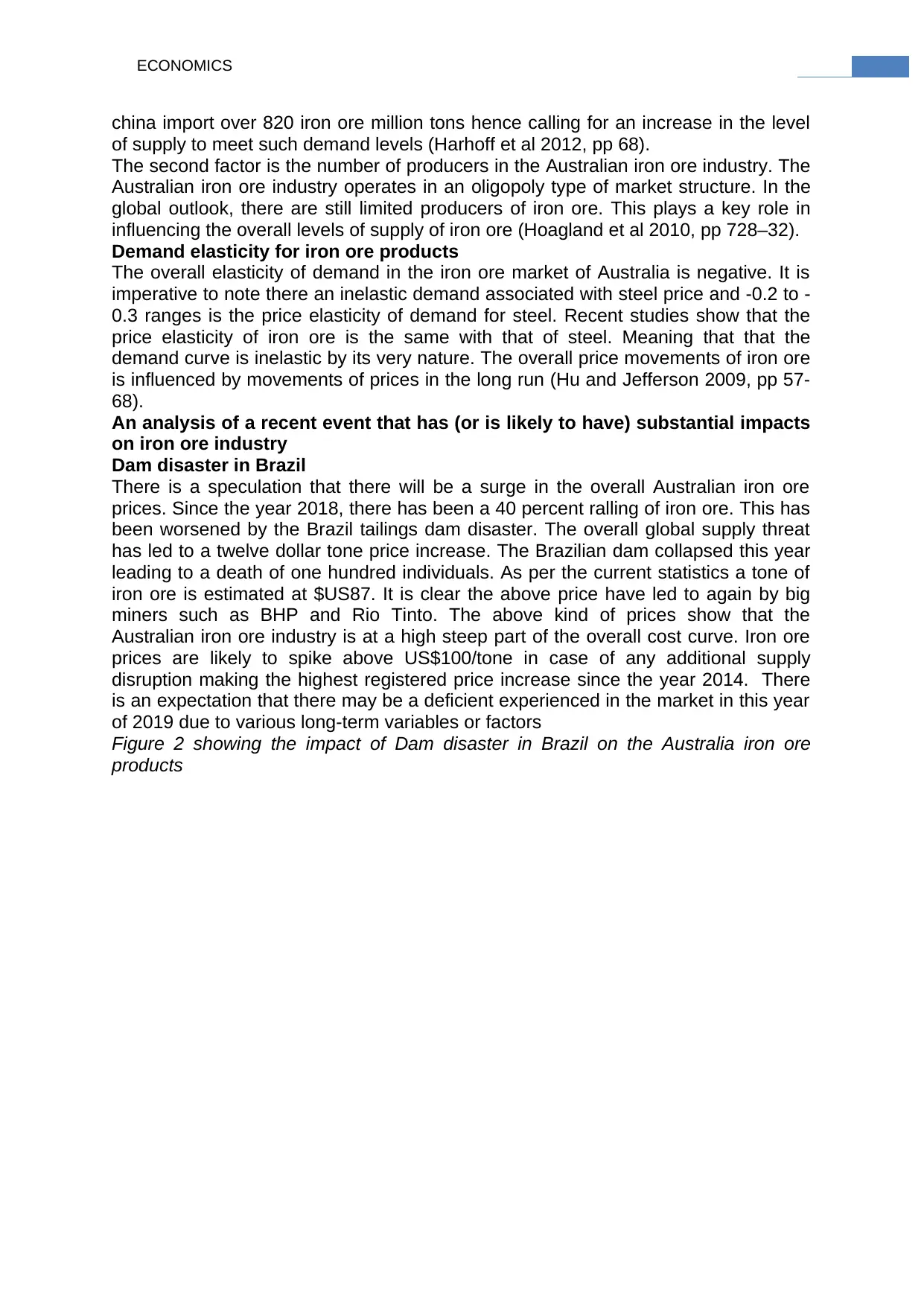
5ECONOMICS
china import over 820 iron ore million tons hence calling for an increase in the level
of supply to meet such demand levels (Harhoff et al 2012, pp 68).
The second factor is the number of producers in the Australian iron ore industry. The
Australian iron ore industry operates in an oligopoly type of market structure. In the
global outlook, there are still limited producers of iron ore. This plays a key role in
influencing the overall levels of supply of iron ore (Hoagland et al 2010, pp 728–32).
Demand elasticity for iron ore products
The overall elasticity of demand in the iron ore market of Australia is negative. It is
imperative to note there an inelastic demand associated with steel price and -0.2 to -
0.3 ranges is the price elasticity of demand for steel. Recent studies show that the
price elasticity of iron ore is the same with that of steel. Meaning that that the
demand curve is inelastic by its very nature. The overall price movements of iron ore
is influenced by movements of prices in the long run (Hu and Jefferson 2009, pp 57-
68).
An analysis of a recent event that has (or is likely to have) substantial impacts
on iron ore industry
Dam disaster in Brazil
There is a speculation that there will be a surge in the overall Australian iron ore
prices. Since the year 2018, there has been a 40 percent ralling of iron ore. This has
been worsened by the Brazil tailings dam disaster. The overall global supply threat
has led to a twelve dollar tone price increase. The Brazilian dam collapsed this year
leading to a death of one hundred individuals. As per the current statistics a tone of
iron ore is estimated at $US87. It is clear the above price have led to again by big
miners such as BHP and Rio Tinto. The above kind of prices show that the
Australian iron ore industry is at a high steep part of the overall cost curve. Iron ore
prices are likely to spike above US$100/tone in case of any additional supply
disruption making the highest registered price increase since the year 2014. There
is an expectation that there may be a deficient experienced in the market in this year
of 2019 due to various long-term variables or factors
Figure 2 showing the impact of Dam disaster in Brazil on the Australia iron ore
products
china import over 820 iron ore million tons hence calling for an increase in the level
of supply to meet such demand levels (Harhoff et al 2012, pp 68).
The second factor is the number of producers in the Australian iron ore industry. The
Australian iron ore industry operates in an oligopoly type of market structure. In the
global outlook, there are still limited producers of iron ore. This plays a key role in
influencing the overall levels of supply of iron ore (Hoagland et al 2010, pp 728–32).
Demand elasticity for iron ore products
The overall elasticity of demand in the iron ore market of Australia is negative. It is
imperative to note there an inelastic demand associated with steel price and -0.2 to -
0.3 ranges is the price elasticity of demand for steel. Recent studies show that the
price elasticity of iron ore is the same with that of steel. Meaning that that the
demand curve is inelastic by its very nature. The overall price movements of iron ore
is influenced by movements of prices in the long run (Hu and Jefferson 2009, pp 57-
68).
An analysis of a recent event that has (or is likely to have) substantial impacts
on iron ore industry
Dam disaster in Brazil
There is a speculation that there will be a surge in the overall Australian iron ore
prices. Since the year 2018, there has been a 40 percent ralling of iron ore. This has
been worsened by the Brazil tailings dam disaster. The overall global supply threat
has led to a twelve dollar tone price increase. The Brazilian dam collapsed this year
leading to a death of one hundred individuals. As per the current statistics a tone of
iron ore is estimated at $US87. It is clear the above price have led to again by big
miners such as BHP and Rio Tinto. The above kind of prices show that the
Australian iron ore industry is at a high steep part of the overall cost curve. Iron ore
prices are likely to spike above US$100/tone in case of any additional supply
disruption making the highest registered price increase since the year 2014. There
is an expectation that there may be a deficient experienced in the market in this year
of 2019 due to various long-term variables or factors
Figure 2 showing the impact of Dam disaster in Brazil on the Australia iron ore
products
⊘ This is a preview!⊘
Do you want full access?
Subscribe today to unlock all pages.

Trusted by 1+ million students worldwide
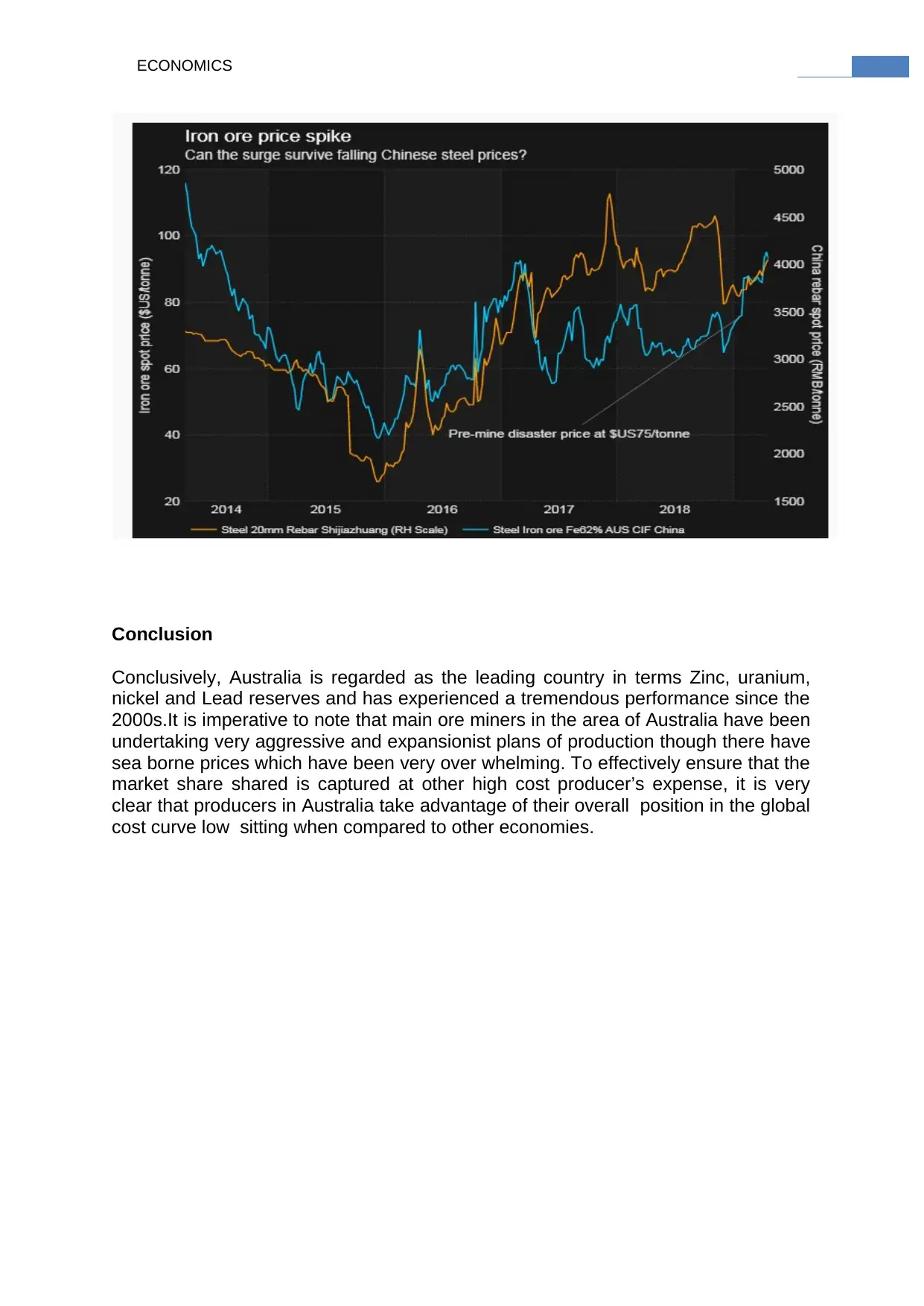
6ECONOMICS
Conclusion
Conclusively, Australia is regarded as the leading country in terms Zinc, uranium,
nickel and Lead reserves and has experienced a tremendous performance since the
2000s.It is imperative to note that main ore miners in the area of Australia have been
undertaking very aggressive and expansionist plans of production though there have
sea borne prices which have been very over whelming. To effectively ensure that the
market share shared is captured at other high cost producer’s expense, it is very
clear that producers in Australia take advantage of their overall position in the global
cost curve low sitting when compared to other economies.
Conclusion
Conclusively, Australia is regarded as the leading country in terms Zinc, uranium,
nickel and Lead reserves and has experienced a tremendous performance since the
2000s.It is imperative to note that main ore miners in the area of Australia have been
undertaking very aggressive and expansionist plans of production though there have
sea borne prices which have been very over whelming. To effectively ensure that the
market share shared is captured at other high cost producer’s expense, it is very
clear that producers in Australia take advantage of their overall position in the global
cost curve low sitting when compared to other economies.
Paraphrase This Document
Need a fresh take? Get an instant paraphrase of this document with our AI Paraphraser
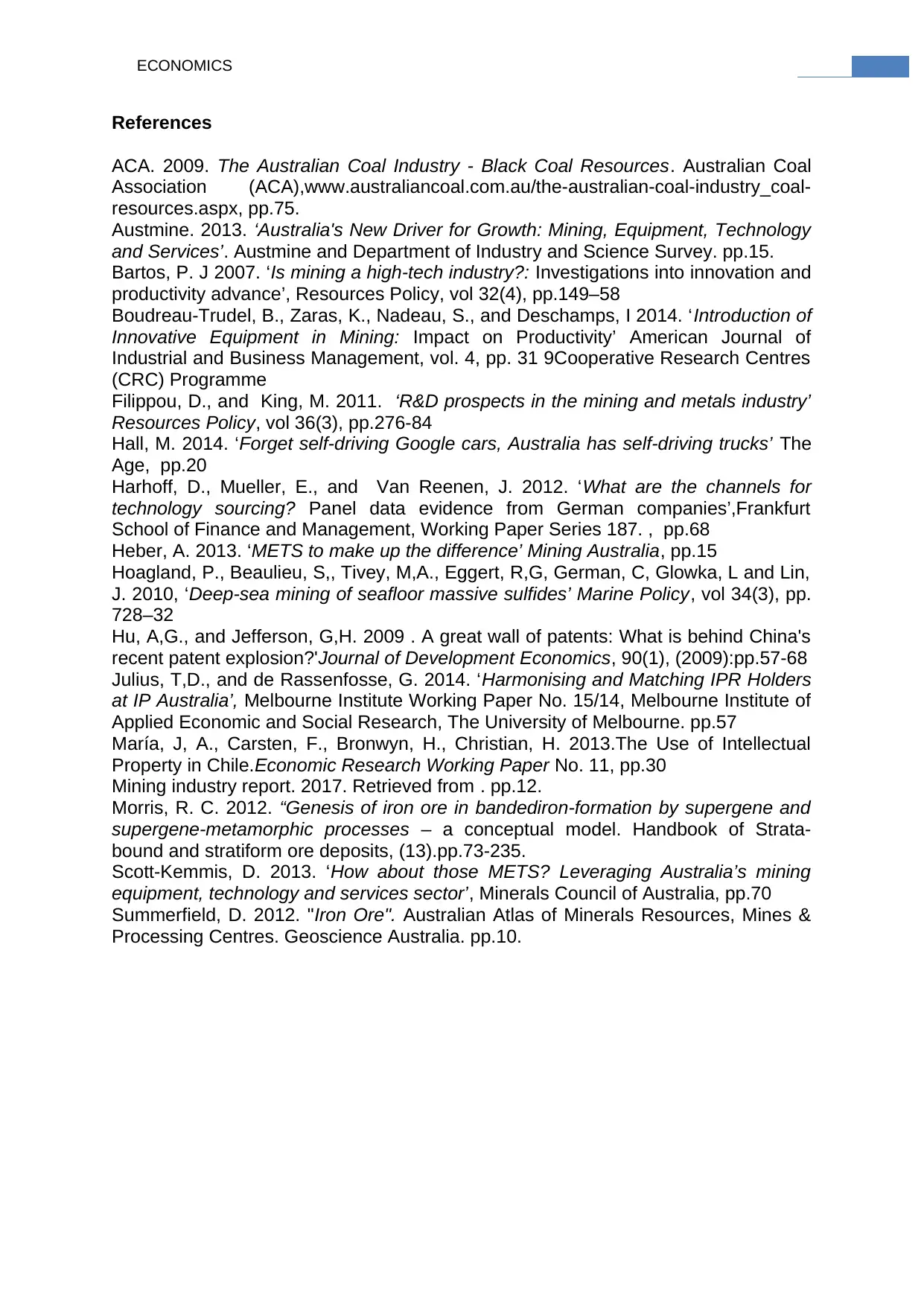
7ECONOMICS
References
ACA. 2009. The Australian Coal Industry - Black Coal Resources. Australian Coal
Association (ACA),www.australiancoal.com.au/the-australian-coal-industry_coal-
resources.aspx, pp.75.
Austmine. 2013. ‘Australia's New Driver for Growth: Mining, Equipment, Technology
and Services’. Austmine and Department of Industry and Science Survey. pp.15.
Bartos, P. J 2007. ‘Is mining a high-tech industry?: Investigations into innovation and
productivity advance’, Resources Policy, vol 32(4), pp.149–58
Boudreau-Trudel, B., Zaras, K., Nadeau, S., and Deschamps, I 2014. ‘Introduction of
Innovative Equipment in Mining: Impact on Productivity’ American Journal of
Industrial and Business Management, vol. 4, pp. 31 9Cooperative Research Centres
(CRC) Programme
Filippou, D., and King, M. 2011. ‘R&D prospects in the mining and metals industry’
Resources Policy, vol 36(3), pp.276-84
Hall, M. 2014. ‘Forget self-driving Google cars, Australia has self-driving trucks’ The
Age, pp.20
Harhoff, D., Mueller, E., and Van Reenen, J. 2012. ‘What are the channels for
technology sourcing? Panel data evidence from German companies’,Frankfurt
School of Finance and Management, Working Paper Series 187. , pp.68
Heber, A. 2013. ‘METS to make up the difference’ Mining Australia, pp.15
Hoagland, P., Beaulieu, S,, Tivey, M,A., Eggert, R,G, German, C, Glowka, L and Lin,
J. 2010, ‘Deep-sea mining of seafloor massive sulfides’ Marine Policy, vol 34(3), pp.
728–32
Hu, A,G., and Jefferson, G,H. 2009 . A great wall of patents: What is behind China's
recent patent explosion?'Journal of Development Economics, 90(1), (2009):pp.57-68
Julius, T,D., and de Rassenfosse, G. 2014. ‘Harmonising and Matching IPR Holders
at IP Australia’, Melbourne Institute Working Paper No. 15/14, Melbourne Institute of
Applied Economic and Social Research, The University of Melbourne. pp.57
María, J, A., Carsten, F., Bronwyn, H., Christian, H. 2013.The Use of Intellectual
Property in Chile.Economic Research Working Paper No. 11, pp.30
Mining industry report. 2017. Retrieved from . pp.12.
Morris, R. C. 2012. “Genesis of iron ore in bandediron-formation by supergene and
supergene-metamorphic processes – a conceptual model. Handbook of Strata-
bound and stratiform ore deposits, (13).pp.73-235.
Scott-Kemmis, D. 2013. ‘How about those METS? Leveraging Australia’s mining
equipment, technology and services sector’, Minerals Council of Australia, pp.70
Summerfield, D. 2012. "Iron Ore". Australian Atlas of Minerals Resources, Mines &
Processing Centres. Geoscience Australia. pp.10.
References
ACA. 2009. The Australian Coal Industry - Black Coal Resources. Australian Coal
Association (ACA),www.australiancoal.com.au/the-australian-coal-industry_coal-
resources.aspx, pp.75.
Austmine. 2013. ‘Australia's New Driver for Growth: Mining, Equipment, Technology
and Services’. Austmine and Department of Industry and Science Survey. pp.15.
Bartos, P. J 2007. ‘Is mining a high-tech industry?: Investigations into innovation and
productivity advance’, Resources Policy, vol 32(4), pp.149–58
Boudreau-Trudel, B., Zaras, K., Nadeau, S., and Deschamps, I 2014. ‘Introduction of
Innovative Equipment in Mining: Impact on Productivity’ American Journal of
Industrial and Business Management, vol. 4, pp. 31 9Cooperative Research Centres
(CRC) Programme
Filippou, D., and King, M. 2011. ‘R&D prospects in the mining and metals industry’
Resources Policy, vol 36(3), pp.276-84
Hall, M. 2014. ‘Forget self-driving Google cars, Australia has self-driving trucks’ The
Age, pp.20
Harhoff, D., Mueller, E., and Van Reenen, J. 2012. ‘What are the channels for
technology sourcing? Panel data evidence from German companies’,Frankfurt
School of Finance and Management, Working Paper Series 187. , pp.68
Heber, A. 2013. ‘METS to make up the difference’ Mining Australia, pp.15
Hoagland, P., Beaulieu, S,, Tivey, M,A., Eggert, R,G, German, C, Glowka, L and Lin,
J. 2010, ‘Deep-sea mining of seafloor massive sulfides’ Marine Policy, vol 34(3), pp.
728–32
Hu, A,G., and Jefferson, G,H. 2009 . A great wall of patents: What is behind China's
recent patent explosion?'Journal of Development Economics, 90(1), (2009):pp.57-68
Julius, T,D., and de Rassenfosse, G. 2014. ‘Harmonising and Matching IPR Holders
at IP Australia’, Melbourne Institute Working Paper No. 15/14, Melbourne Institute of
Applied Economic and Social Research, The University of Melbourne. pp.57
María, J, A., Carsten, F., Bronwyn, H., Christian, H. 2013.The Use of Intellectual
Property in Chile.Economic Research Working Paper No. 11, pp.30
Mining industry report. 2017. Retrieved from . pp.12.
Morris, R. C. 2012. “Genesis of iron ore in bandediron-formation by supergene and
supergene-metamorphic processes – a conceptual model. Handbook of Strata-
bound and stratiform ore deposits, (13).pp.73-235.
Scott-Kemmis, D. 2013. ‘How about those METS? Leveraging Australia’s mining
equipment, technology and services sector’, Minerals Council of Australia, pp.70
Summerfield, D. 2012. "Iron Ore". Australian Atlas of Minerals Resources, Mines &
Processing Centres. Geoscience Australia. pp.10.

8ECONOMICS
Appendix
Figure three showing global iron ore products costs
Appendix
Figure three showing global iron ore products costs
⊘ This is a preview!⊘
Do you want full access?
Subscribe today to unlock all pages.

Trusted by 1+ million students worldwide
1 out of 9
Related Documents
Your All-in-One AI-Powered Toolkit for Academic Success.
+13062052269
info@desklib.com
Available 24*7 on WhatsApp / Email
![[object Object]](/_next/static/media/star-bottom.7253800d.svg)
Unlock your academic potential
Copyright © 2020–2025 A2Z Services. All Rights Reserved. Developed and managed by ZUCOL.





